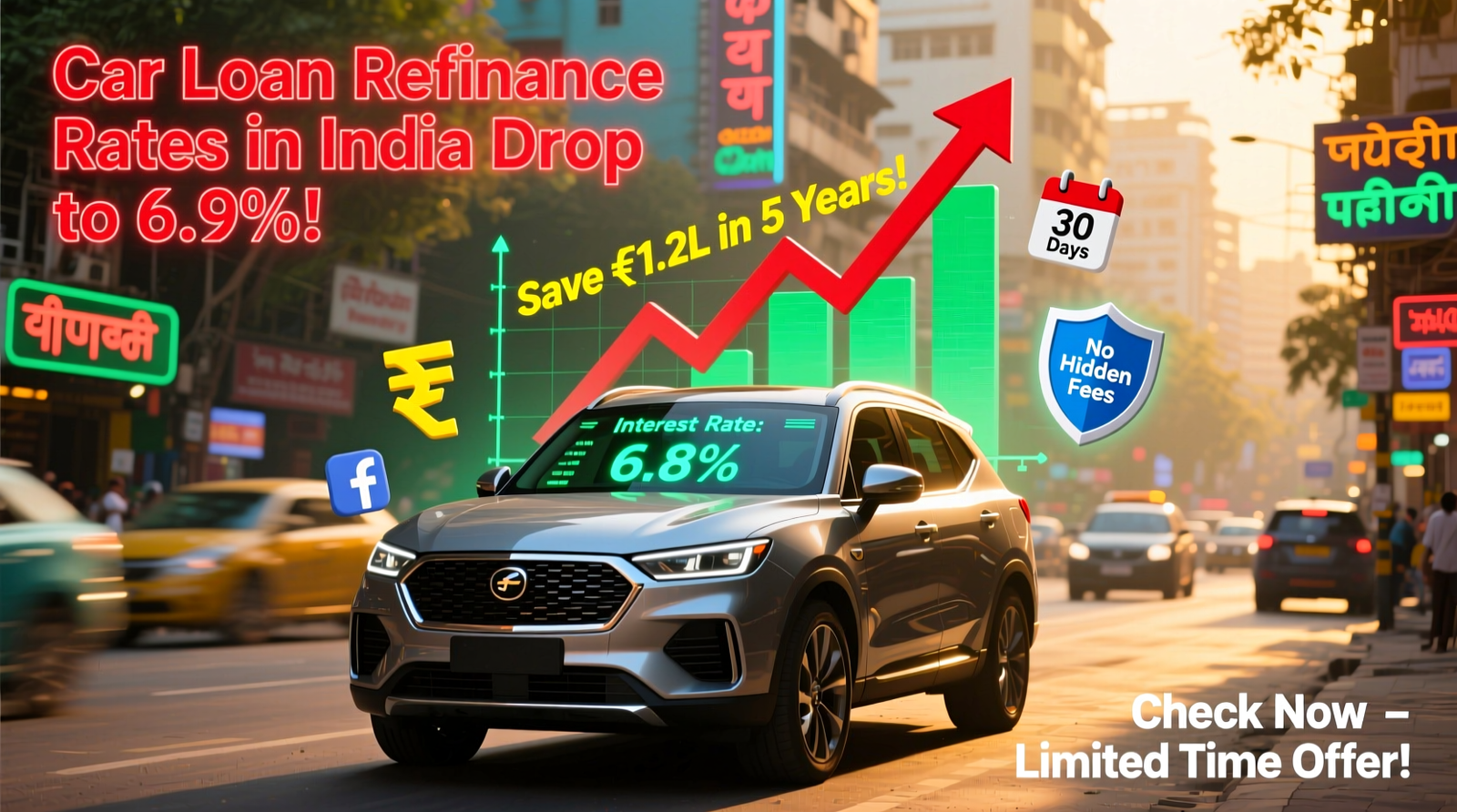If you’re cruising down the highway in your trusty car, but every month, that EMI payment feels like a speed bump hitting your wallet harder than expected. What if I told you there’s a straightforward way to ease that burden without trading in your ride?
That’s right—refinancing your existing car loan could lower your interest rates significantly, putting more cash back in your pocket. In today’s fluctuating economy, with rates starting as low as 8.50% for new car loans as of September 2025, it’s the perfect time to explore this option.
Stick with me as we dive into the world of car loan refinance interest rates in India, and I’ll show you exactly how to make it work for you.
What Exactly Is Car Loan Refinancing?
Let’s break it down simply. Refinancing a car loan means taking out a new loan to pay off your current one, ideally at a better interest rate or with more favorable terms.
It’s not about buying a new car; it’s about optimizing the financing on the one you already own. This process is especially popular in India, where auto loan rates have been adjusting due to RBI’s repo rate pauses at 6.5%.
Why consider it? If your original loan was taken when rates were higher—say, above 10%—switching to a lender offering rates around 9% or lower can reduce your monthly outflows.
For instance, public and private banks are now providing refinance options tailored for used cars, where rates can dip to competitive levels based on your profile.
According to experts, this move can save borrowers thousands over the loan tenure, making it a smart financial tweak for anyone with an existing auto debt.
Current Car Loan Refinance Interest Rates in India (September 2025)
As of mid-September 2025, the landscape for car loan refinance rates is encouraging, influenced by stable inflation trends and bank competitions. Rates vary by lender, your credit score, loan amount, and whether it’s for a new or used vehicle.
Generally, refinance rates for used cars (common for refinancing) start higher than new car loans but are still attractive compared to older deals.
To give you a clear snapshot, here’s a comparison table of refinance or used car loan interest rates from major banks. This focuses on starting rates for eligible borrowers with good credit (above 750 CIBIL score):
| Bank/Lender | Starting Interest Rate (p.a.) | Key Notes on Refinance |
|---|---|---|
| ICICI Bank | 9.00% | Based on customer relationship; up to 100% on-road funding for refinance variants. |
| HDFC Bank | 8.80% | Attractive for used cars; flexible tenures up to 7 years. |
| SBI | 8.50% | Transparent schemes; ideal for salaried individuals refinancing existing loans. |
| Axis Bank | 10.15% | For tenures up to 36 months; processing fee around 1% of loan amount. |
| IDFC FIRST Bank | 13.99% (Refinance specific) | Low as 11.99% for repurchase; minimal documentation for quick approval. |
These rates are indicative and subject to change based on RBI guidelines and individual eligibility. For the most up-to-date figures, check directly with the banks—I’ve linked a couple of reliable sources above for easy access. Remember, a higher credit score can shave off 1-2% from these baselines.
Why Refinance Your Car Loan Now? The Real Benefits
Timing is everything, and with retail inflation at 5.49% in recent months, banks are eager to attract refinancers. If your current rate is above 10%, switching could lower your EMI by 10-20%. Plus, you might extend the tenure to spread payments or opt for a shorter one to pay off faster.
Take a typical scenario: A ₹5 lakh outstanding loan at 12% interest over 3 years has an EMI of about ₹15,800. Refinancing to 9% drops it to ₹14,900—saving over ₹27,000 in total interest. Tools like online EMI calculators from sites such as BankBazaar can help you crunch these numbers personalized to your situation.
Another perk? Many lenders now offer 100% financing on the outstanding amount for refinance, minimizing any upfront costs. Just ensure your car’s age (typically under 7 years for eligibility) and valuation align with the new lender’s criteria.
Step-by-Step Guide: How to Refinance Your Car Loan
Ready to get started? Here’s a no-fuss process to follow:
- Assess Your Current Loan: Review your existing EMI, interest rate, outstanding balance, and remaining tenure. Calculate potential savings using a refinance calculator.
- Check Eligibility: You need a stable income (salaried or self-employed), CIBIL score above 700, and your car should be less than 5-7 years old. Documents include ID proof, income statements, and current loan details.
- Compare Lenders: Shop around using comparison platforms. Look beyond rates—factor in processing fees (0.5-1% of loan) and prepayment charges on your old loan (up to 4% in some cases).
- Apply for the New Loan: Submit applications to 2-3 banks. Once approved, the new lender pays off the old one directly, and you start fresh EMIs.
- Finalize and Monitor: Get the no-objection certificate (NOC) from your previous lender and update hypothecation with RTO if needed. Track your new loan via the bank’s app for seamless management.
Pro tip: Avoid refinancing if you’ve already paid off most of the principal or if prepayment penalties outweigh savings. Always read the fine print to dodge hidden fees.
Potential Drawbacks and Tips to Avoid Them
No strategy is flawless. Refinancing might extend your debt period or involve paperwork hassles. If rates rise post-RBI reviews, your new fixed-rate loan could lock in benefits, but floating rates carry risks.
To maximize gains: Improve your credit score beforehand, negotiate with lenders, and consider balance transfer offers from your current bank.
Wrapping It Up: Take Control of Your Finances Today
There you have it—refinancing your car loan in India isn’t just a financial jargon; it’s a practical step to lighter EMIs and smarter saving in 2025. With rates hovering around 8.5-10% for most, now’s your chance to refinance and drive towards better financial health.
If you’ve got questions or need personalized advice, drop a comment below—I’m here to help navigate this with you.

